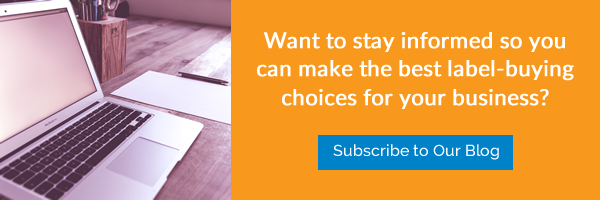
You’re at the store to buy soap and your regular brand isn’t available. Staring at the wall of unfamiliar, but similar products … which do you choose?
If you’re like the average consumer, you’ll make your decision in seconds. You’ve got things to do and other products to buy. You can’t spend all day in front of one shelf.
You reach out your hand and grab ... the one with the eye-catching label.
When consumers don’t know anything else about the quality of a brand, they’ll often pick the item that’s most visually appealing to them. On crowded shelves, as your products jockey for attention among dozens of competitors, there’s no better way to show off your brand’s style than with a distinctive label.
How can you give your brand an edge with a bit of attention-getting flair? Ask your label printer if they offer any of these modern product-label elements.
1. Interesting Textures and Unique Materials
Imagine a dark amber bottle. The label is perfectly clear, with shimmering gold lettering, emphasized and framed only by the brown glass behind it. It’s a much more appealing picture than the usual white label with dark lettering, isn’t it? The clear label offers a sense of class and quality — maybe even a little mystery.
The materials and textures you use for your labels can express your brand identity. You can opt to give your paper the crinkle treatment, for example, for a roughed-up, leather-like effect. Or you can achieve a handcrafted feel with a wood veneer.
2. Metallic Effects
Different metals — gold, bronze, brass, pewter, platinum — can signify purity, durability, tradition, or luxury. And they can all be captured on your label with the right materials in the hands of creative press operators.
There’s a range of techniques available for applying metallic elements or creating metallic effects. What your printer can do will depend in part on what equipment they have. The rest is up to their creativity. A skilled label printer might even combine different printing techniques to adjust things like opacity and intensity, drawing out varying tones of the same metal.
3. Digital Printing Processes
Digital printing is printing without plates. A digital printing press takes images directly from a digital file (such as a pdf) and prints them on of the material that will be used to make your labels.
One advantage of digital printing over traditional methods is variability. Digital printing allows an almost infinite range of variation. Let’s say you have a line of sauces; maybe ten different flavors. You sell these as private label products for independent grocers, serving a few hundred stores with these sauces. The contents may be the same, but you want your grocers to have their own store branding on the labels. And, they each get a unique SKU. You also serialize all the bottles to help with your own internal controls.
This scenario presents a lot of challenges for traditional printing methods. It could be done, but your printer would be trading efficiency in several areas for meeting your requirements. Traditionally, this kind of work might have been done by printing “blanks” that bear some of the information, and maybe graphics, and then running the blanks through small industrial printer (likely better suited for shipping labels) to add the variable information. Digital presses are ideally suited to this type of work.
With digital printing, you can also mix up lettering and imagery within one mass printing. Did you wonder how Coca-Cola managed to create bottle labels with hundreds of different names (without a printer having to re-tool the press for every single name)? Digital printing made it happen.
4. Interactivity
Ink, paper, plastic, adhesive — labels are relatively low-tech items. But thanks to the digital devices most of us carry around with us, labels can be used to trigger high-tech experiences.
Consider the example of Australian winemaker 19 Crimes. Each of the brand’s labels features a picture of a British prisoner who was sent to Australia in the 18th century for reasons ranging from grand larceny to bigamy to … impersonating an Egyptian.
When you scan the image with a custom app on your smartphone, the picture will come to life, telling the convict’s side of the story. The technology, called Augmented Reality, uses elements of the printed image to launch the related video experience. It’s a clever and fun way to tie that brand back to its nation’s colorful history.
The makers of Oreo cookies have experimented with interactive elements as well. For one holiday promotion, they let cookie buyers customize their packages online, manipulating the size and color of seasonal imagery. The company also offered black and white versions of the custom packages (coloring book style) for those who wanted to do the coloring by hand.
5. Brand Protection
Your loyal customers want to be sure they’re getting the genuine article, not some shoddy knock-off. Overt security features like holograms, microprint, and special inks make your products harder to counterfeit and reassure buyers that you take their trust seriously.
Adding covert features and including simple things like serial numbers and barcodes to support track-and-trace platforms helps you definitively identify your products and follow them throughout your supply chain. Incorporating elements like these into your labels can help to combat black market sales of counterfeits as well as gray market practices, like product diversion, that can hurt your reputation and steal your profits.
Learn more about the latest covert and overt security label features in our recent article, “Security Labels: How Do They Work (And Do You Need Them?)”
Learn How to Choose the Right Label for Your Brand
Choosing from among the many options that will help your label stand out can be overwhelming. That’s without even mentioning the different materials, inks, and adhesives available. Make sure to visit our blog to get the latest news and helpful information that will make your label-buying journey easier than ever before.

